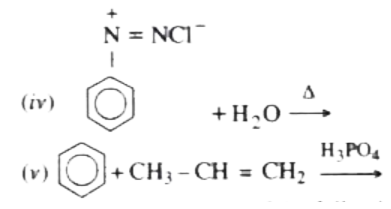Name the following reaction.
PhCHO+CH2(COOEt)2(i)Pyridine−−−−−−−−−→(ii)H2O(iii)Δ,−CO2Ph−CH≡CHCOOH
Perkin reaction
Aldol condensation
Claisen reaction
Knoevenagel
The correct Answer is:D
To name the reaction given in the question, we will analyze the components and the conditions under which the reaction occurs.
1. Identify the Reactants: The reactants in the reaction are benzaldehyde (PhCHO) and diethyl malonate (CH₂(COOEt)₂). Benzaldehyde is an aromatic aldehyde, and diethyl malonate contains an active methylene group.
2. Identify the Conditions: The reaction occurs in the presence of pyridine, which acts as a weak base, and water is also involved in the reaction. The reaction is followed by heating (indicated by Δ) and the release of carbon dioxide (CO₂).
3. Analyze the Reaction Type:
- The reaction involves an aromatic aldehyde (benzaldehyde) and an ester (diethyl malonate).
- The presence of an active methylene group (the methylene group between two carbonyls in diethyl malonate) is crucial for the reaction to proceed.
- The reaction does not involve any alpha hydrogen from the benzaldehyde since it does not have any.
4. Determine the Name of the Reaction:
- This reaction fits the criteria of the Noyori Reaction (also known as the Noyori Aldol Reaction or Noyori Condensation). In the Noyori reaction, an aldehyde or ketone with no alpha hydrogen reacts with a compound containing an active methylene group in the presence of a weak base to form an unsaturated carboxylic acid.
5. Final Product: The product formed is an unsaturated carboxylic acid (Ph-CH=CHCOOH), confirming that the reaction is indeed a condensation reaction leading to the formation of an unsaturated acid.
Conclusion:
The name of the reaction is the Noyori Reaction.
---
- The reaction involves an aromatic aldehyde (benzaldehyde) and an ester (diethyl malonate).
- The presence of an active methylene group (the methylene group between two carbonyls in diethyl malonate) is crucial for the reaction to proceed.
- The reaction does not involve any alpha hydrogen from the benzaldehyde since it does not have any.
- This reaction fits the criteria of the Noyori Reaction (also known as the Noyori Aldol Reaction or Noyori Condensation). In the Noyori reaction, an aldehyde or ketone with no alpha hydrogen reacts with a compound containing an active methylene group in the presence of a weak base to form an unsaturated carboxylic acid.
The name of the reaction is the Noyori Reaction.
Topper's Solved these Questions
- ALIPHATIC AND AROMATIC ALDEHYDES AND KETONESBOOK - CENGAGE CHEMISTRY ENGLISHCHAPTER - ALIPHATIC AND AROMATIC ALDEHYDES AND KETONESEXERCISE - Exercises Assertion-Reasoning
6 Videos
- ALIPHATIC AND AROMATIC ALDEHYDES AND KETONESBOOK - CENGAGE CHEMISTRY ENGLISHCHAPTER - ALIPHATIC AND AROMATIC ALDEHYDES AND KETONESEXERCISE - Archives Objective
10 Videos
- ALIPHATIC AND AROMATIC ALDEHYDES AND KETONESBOOK - CENGAGE CHEMISTRY ENGLISHCHAPTER - ALIPHATIC AND AROMATIC ALDEHYDES AND KETONESEXERCISE - Exercises Multiple Correct
33 Videos
- ALCOHOL,PHENOL AND ETHERSBOOK - CENGAGE CHEMISTRY ENGLISHCHAPTER - ALCOHOL,PHENOL AND ETHERSEXERCISE - Archives Analytical And Descriptive
15 Videos
- APPENDIX INORGANIC VOLUME 2BOOK - CENGAGE CHEMISTRY ENGLISHCHAPTER - APPENDIX INORGANIC VOLUME 2EXERCISE - Short Answer Type
179 Videos
Similar Questions
Knowledge Check
Compounds (A) and (C ) in the following reactions are
CH3CHO(i)CH3MgBr−−−−−−−−→(ii)H2O(A)H2SO4,Δ−−−−−−→(B)Hydroboration oxidation−−−−−−−−−−−−−−→(C)AidenticalBpositional isomersCfunctional isomersDoptical isomers.
Products of the following reaction,
CH3−C≡CCH2CH3(i)O3−−−−−−−−→(ii)Hydrolysis? are:
View SolutionThe product "A" in the following reaction is :CH3−CO−CH2COOC2H5NaOH−−−−−−→H2OA
View SolutionConsider the following reactions
I.
II.(CH3)2C∣OH−CH2−CHOΔ−−→
III. (CH3)2CHCH2−C∣FH−CH3CH3O−Na+−−−−−−−−−−→Δ
IV. (CH3)2CH−C∣BrH−CH3(CH3)3CO−k+−−−−−−−−−−→
Which of these reaction will not produce Hoffmann product?
View SolutionPredict the major product in the following reaction :
C6H5−CH2CO2CH3(i)CH3MgBr(Excess)−−−−−−−−−−−−−−→(ii)H⊕.
View SolutionComplete the following reactions :
(i) CH3−CH2−C≡C−CH2−(CH2)6−CH2OH(i)Na/NH3(I)−−−−−−−−−−→(ii)H2O
(ii)
View SolutionComplete the following reactions :
(i) (CH3)2COLiAlH4−−−→
(ii)
(iii) CH3CH∣OH−CH3+PCl5→ (iv)

View SolutionGive the formulae of [A] and [B]
CH3CH2MgBr+CO2(i)Dry ether−−−−−−−−→(ii)H+/H2O[A]PCl5−−→[B]
View Solution
